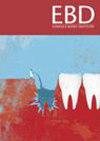重要牙髓治疗的临床实践指南和立场声明的质量评估:系统回顾。
IF 2.3
Q3 Dentistry
引用次数: 0
摘要
目的:利用研究和评估指南II (AGREE II)和研究和评估-推荐卓越指南(AGREE- rex)工具评估重要牙髓治疗(VPT)的不同临床实践指南(CPGs)和立场声明(PS)。方法:两位作者在六个数据库中使用一组关键词进行初步搜索。仅包括过去五年发表的关于VPT的cpg和PS。所纳入的cpg由6位评价者独立评价。采用AGREE II工具评价方法学质量,采用AGREE REX工具评价推荐的质量。用类内相关系数作为评估者之间的信度指标。结果:4篇已发表的cpg入选。对欧洲牙髓学学会(ESE, 2019)、德国牙髓学和口腔创伤学学会(GSEDT, 2019)、美国牙髓医师协会(AAE, 2021)和澳大利亚牙科协会(ADA, 2021)制定的指南进行分析。ESE PS获得了最高的平均分。讨论:牙髓医生必须遵守专业协会或协会制定的临床实践指南。改善“发展的严谨性”和“适用性”两个范畴,是提升指引整体实力的必要条件。必须通过确保各种根管协会之间的凝聚力来防止从业人员对VPT程序的气馁和混淆。结论:该评估有助于确定不同专业学会和协会的CPGs标准。它还强调了为建立强有力的以证据为基础的VPT标准所需的基本未来行动和倡议。注册:本系统评价的方案已在PROSPERO注册(ID: CRD42023429673)。本文章由计算机程序翻译,如有差异,请以英文原文为准。

Quality assessment of clinical practice guidelines and position statements on vital pulp therapy: a systematic review
To evaluate different Clinical Practice Guidelines (CPGs) and Position Statements (PS) on Vital Pulp Therapy (VPT) using the Appraisal of Guidelines for Research and Evaluation II (AGREE II) and Appraisal of Guidelines for Research and Evaluation—Recommendation EXcellence (AGREE-REX) tools. Two authors performed the initial search using a set of keywords in six databases. Only CPGs and PS on VPT published during the past five years were included. The included CPGs were appraised independently by six appraisers. AGREE II tool was used to evaluate the methodological quality, and AGREE REX was used to evaluate the quality of recommendations. Intraclass correlation coefficient was used as a reliability indicator among assessors. Four published CPGs were shortlisted. Guidelines established by the European Society of Endodontology (ESE, 2019), German Society of Endodontology and Dental Traumatology (GSEDT, 2019), American Association of Endodontists (AAE, 2021), and Australian Dental Association (ADA, 2021) were analyzed. The ESE PS obtained the highest average score overall. Endodontists must adhere to clinical practice guidelines established by specialty associations or societies. Improving the domains “Rigour of Development” and “Applicability” is necessary to enhance the overall strength of the guidelines. It is imperative to prevent discouragement and confusion among practitioners regarding VPT procedures by ensuring cohesiveness among various endodontic associations. This assessment aids in determining the standard of CPGs among different specialized societies and associations. It also highlights the essential future actions and initiatives needed to establish robust evidence-based standards on VPT. Registration: The protocol of this systematic review was registered in PROSPERO (ID: CRD42023429673).
求助全文
通过发布文献求助,成功后即可免费获取论文全文。
去求助
来源期刊

Evidence-based dentistry
Dentistry-Dentistry (all)
CiteScore
2.50
自引率
0.00%
发文量
77
期刊介绍:
Evidence-Based Dentistry delivers the best available evidence on the latest developments in oral health. We evaluate the evidence and provide guidance concerning the value of the author''s conclusions. We keep dentistry up to date with new approaches, exploring a wide range of the latest developments through an accessible expert commentary. Original papers and relevant publications are condensed into digestible summaries, drawing attention to the current methods and findings. We are a central resource for the most cutting edge and relevant issues concerning the evidence-based approach in dentistry today. Evidence-Based Dentistry is published by Springer Nature on behalf of the British Dental Association.
 求助内容:
求助内容: 应助结果提醒方式:
应助结果提醒方式:


